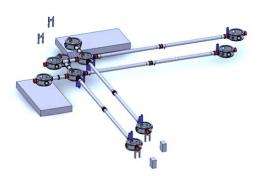October 28, 2010 weblog
Holometer experiment to test if the universe is a hologram

(PhysOrg.com) -- Many ideas in theoretical physics involve extra dimensions, but the possibility that the universe has only two dimensions could also have surprising implications. The idea is that space on the ultra-small Planck scale is two-dimensional, and the third dimension is inextricably linked with time. If this is the case, then our three-dimensional universe is nothing more than a hologram of a two-dimensional universe.
This idea of the holographic universe is not new, but physicists at Fermilab are now designing an experiment to test the idea. Fermilab particle astrophysicist Craig Hogan and others are building a holographic interferometer, or “holometer,” in an attempt to detect the noise inherent in spacetime, which would reveal the ultimate maximum frequency limit imposed by nature.
As Hogan explains in a recent issue of Fermilab's symmetry magazine, the holometer will be “the most sensitive measurement ever made of spacetime itself.” Hogan and others have already built a one-meter-long prototype of the instrument. They have just begun building the entire 40-meter-long holometer and plan to start collecting data next year.
The holometer consists of two completely separate interferometers positioned on top of one other. In each interferometer, a light beam is split into two different parts that travel in different directions. After bouncing off a mirror, the light beams are brought back together where the difference in their phases is measured. Even the smallest vibration will interfere with the light's frequency during its travels and cause the two light beams to be out of sync.
While interferometers have been used for more than 100 years, the key to the holometer is achieving extreme precision at high frequencies. The scientists say that the holometer will be seven orders of magnitude more precise than any atomic clock in existence over very short time intervals. By having two interferometers, the researchers can compare them to confirm measurements. In addition, the scientists are making sure that any vibration that is detected isn't coming from the holometer itself. They will arrange sensors outside the holometer to detect normal vibrations, and then cancel these vibrations by shaking the mirrors at the same frequency.
After taking these precautions, any detected high-frequency noise could be the jitter of spacetime itself, or “holographic noise.” The noise is expected to have a frequency of a million cycles per second, which is a thousand times higher than what the human ear can hear, noted Fermilab experimental physicist Aaron Chou. If the experiment does find this holographic noise, it would be the first glimpse beyond our three-dimensional illusion and into the universe's true two-dimensional nature at the Planck scale.
More information: via: symmetry magazine
© 2010 PhysOrg.com



















